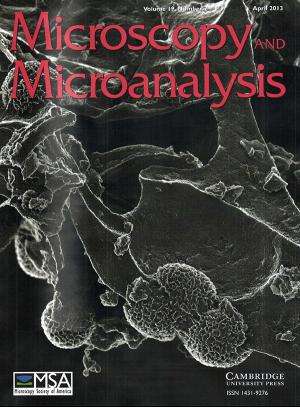Scientists reveal morphology, growth mechanisms of precipitates from carbon dioxide storage

(Phys.org) —Capturing carbon dioxide and storing it in underground rock formations is one proposed solution to mitigate climate change. New knowledge about the chemical reactions between stored carbon dioxide and forsterite (Mg2SiO4) is helping determine how much confidence can be placed in using igneous rocks with magnesium-rich olivines for long-term carbon sequestration. Scientists at Pacific Northwest National Laboratory determined that the carbon dioxide and forsterite react to form hydrated dypingite [(Mg5(CO3)4•5H2O)], which precipitates from solution.
The hydrated dypingite precipitates grow by different mechanisms and with a different morphology based on whether the starting phase is synthetic forsterite or the natural form. In synthetic forsterite, magnesium solutions seeped into pores where evaporation left rosettes of dypingite behind. On natural forsterite, dypingite precipitates formed only on the surface and in rod-like structures. This finding, made possible by multimodal high-resolution imaging and spectroscopic analysis, gives new insight into the geochemistry of supercritical carbon dioxide storage. Images from this research graced the cover of Microscopy and Microanalysis.
Generating electricity from coal and other fossil fuels accounts for just over half of the planet's human-made carbon dioxide emissions. Carbon dioxide emissions contribute to changes in weather patterns that affect crops, water availability, and air quality. Capturing and sequestering carbon dioxide could mitigate its effects, but fundamental questions need to be answered about the reactions that would occur during storage. By understanding the basic interactions between carbon dioxide and the minerals in low water situations at sequestration sites, scientists can inform engineers, policymakers, and others about different options.
To store carbon dioxide waste, such as from industrial processing, it would need to be captured, condensed under high pressure and high temperature, and converted to supercritical carbon dioxide-a fluid with both gas and liquid properties that could then be injected deep underground. Researchers mimicked these deep underground conditions, incubating the carbon dioxide in a highly humid environment with forsterite. They used imaging, including helium ion microscopy, as well as chemical analysis techniques at EMSL to study the changes in the chemistry of the system ex situ.
Critical to their studies, the research team developed a new sample preparation protocol to preserve the very fragile reaction products that formed under the high-pressure and high-temperature experimental conditions.
Drawing on the Lab's nearly 50 years of expertise in subsurface science, the team is continuing to delve into the reactions that would occur between carbon dioxide and different minerals found deep underground.
More information: Arey, B. et al. 2013. Investigation of Mineral Transformations in Wet Supercritical CO2 by Electron Microscopy, Microscopy and Microanalysis 19(2):268-275. DOI: 10.1017/S1431927612014171
Provided by Pacific Northwest National Laboratory

















